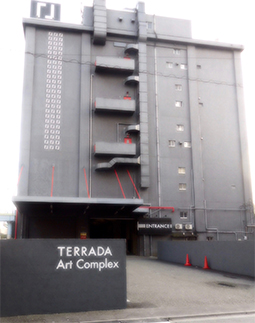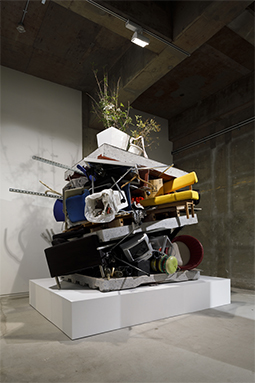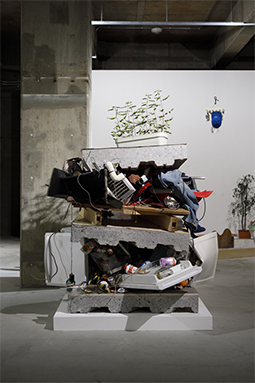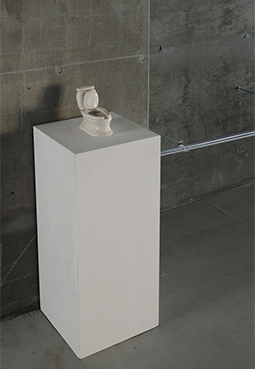 |
|
Here and There introduces art, artists, galleries and museums around Japan that non-Japanese readers and first-time visitors may find of particular interest. The writer claims no art expertise, just a subjective viewpoint acquired over many years' residence in Japan.
|
|
 |
|
|
 |
 |
Rumble in the Rubble: Chim↑Pom at Anomaly
Alan Gleason |
 |
Conceptional Drawing of "Grand Open" Exhibition (2018), H59.5 x W84 cm, water color on paper, special print. Painted by Keiji Itagaki. © Chim↑Pom. Photo by Kenji Morita, courtesy of Anomaly, Tokyo |
To its burgeoning repertoire of artistic firsts, the rambunctious Tokyo collective Chim↑Pom has now added the building-burger. Instead of beef patties, we get layers of junk sandwiched between slices of concrete floor that were hacksawed vertically through several stories of a building undergoing demolition. This and other wonders are on display through 26 January 2019 at Anomaly, a just-opened contemporary art gallery whose stark concrete spaces provide a fitting backdrop to Chim↑Pom's musings on the eternal cycle of urban destruction and renewal.
Perhaps that's one reason Chim↑Pom was invited to open Anomaly, a joint undertaking by three galleries -- Yamamoto Gendai, Urano, and Hashimoto Art Office -- that occupies the fourth floor of Terrada Art Complex, a recently refurbished warehouse owned by Shinagawa waterfront developer Warehouse Terrada. The complex itself represents the culmination of a years-long process of assimilation of Tokyo's do-it-yourself contemporary art scene into the city's commercial fabric. For the last couple of decades many of the capital's more intrepid galleries have rented and remodeled unused space in warehouses in industrial neighborhoods, only to have to move on when the buildings were torn down to make way for more highrises. Now developers are converting warehouses into permanent homes for galleries and other tenants -- a blessing for the art world, but one contingent on large infusions of capital that the early galleries never had at their disposal.
|
 |
|
|
|
The Terrada Art Complex building in Shinagawa, Tokyo. Photo by Alan Gleason
|
If it strikes some of Chim↑Pom's fans that these self-styled urban guerillas are getting cozy with the forces of gentrification, the group, which revels in precisely such contradictions, is the first to admit it. As a sort-of-manifesto handed out at Anomaly says, "[E]ven on the side of the players driving up land prices ... there are artists, ironically enough! ... [I]n this case, for instance, it would be Chim↑Pom, who are doing the honors for the official opening of Anomaly. LOL. What a mystifying business!" ... And yet it's nice to know that the Terrada galleries, at least, have found a home they won't soon be evicted from, or so one hopes.
Titled Grand Open, the Chim↑Pom show references not just the gallery's opening but also the hucksterism surrounding new shopping complexes and redevelopment projects throughout Tokyo, "where renewal has become the default selection." For their part, they aspire to "a 'grand opening' that is genuinely open as all hell." The centerpiece of this opening is actually a recent Chim↑Pom project in another part of town, Shinjuku's seedy Kabukicho quarter, where the group presided over the closure of a building slated for demolition. In the vacated Kabukicho Book Center they set up a "Ningen [Human] Restaurant," served food, held various events, and, at the end of their two-week residency, demolished part of the building themselves.
The legacy of that process, reconstructed at Anomaly, is the building-burger mentioned above. Four meters high, it consists of a stack of three chunks of concrete floor, each about three meters square, that balance precariously atop meter-high piles of random junk scavenged from the building. A slightly smaller variant stands nearby. These are strangely solemn, even archaeological constructions, and the "meat" of the sandwiches -- the discarded junk -- is a marvelous cataloging of the detritus of modern urban life: sofas, empty cans, clothing, computer equipment, you name it.
 |
|
 |
|
|
|
Big and little Building-Burgers (2018), H400 x W360 x D280 cm (left) and H186 x W170 x D155 cm (right). Floors cropped out from the Ningen Restaurant building, various junk. © Chim↑Pom. Photo by Kenji Morita, courtesy of Anomaly, Tokyo |
One inspiration for Ningen Restaurant was the booming popularity of Robot Restaurant, a major tourist attraction right across the street that is viewed as a harbinger of Kabukicho's transformation from a mob-run warren of bars and massage parlors into a family-friendly entertainment destination. Though Chim↑Pom avers that it is not opposed to the scrap-and-build ethic per se, it mocks the intentions of developers bent on making Tokyo more squeaky-clean -- just in time for the Olympics -- and questions whether there will be a place in that brave new world for homeless people, artists and others on society's margins.
Another incentive for the Kabukicho installation was the experience of just such an artist, Chim↑Pom cohort Osamu Matsuda, who was ousted from a public park for looking suspicious, or perhaps merely scruffy. The ongoing privatization of formerly public spaces, and the underlying ambiguity of the boundary between "private" and "public," are themes that crop up in much of the group's work. This show introduces one such project, The Street, held at the National Taiwan Museum of Fine Arts as part of the 2017 Asian Art Biennial. There the group laid a narrow strip of rough asphalt pavement from the boulevard outside all the way into the museum lobby and declared this "street" open to public access. The crux of the installation was not the pavement so much as the process of negotiation over what behaviors would be permitted on this strip of "public" incursion into private property. The museum grudgingly agreed, for example, to the drinking of alcohol as long as it was "an integral part of the performance," but drew the line at smoking indoors. Video footage shows Ellie, the public face of Chim↑Pom, standing on a beer crate in front a crowd in the lobby and triumphantly raising a glass of sake to her lips.
 |
|
Street (2018), fragments of street produced at National Taiwan Museum of Fine Arts in 2017-2018, carpets, architectural plan model, regulation sheets, documentary video (15 min 8 sec); dimensions variable. © Chim↑Pom. Photo by Kenji Morita, courtesy of Anomaly, Tokyo |
One more video well worth watching is a documentary by the French filmmaker Constant Voisin about Ningen Restaurant and, more generally, the changes coming to Kabukicho. Viewers can sit on concrete blocks extracted from the demolished building and peruse the restaurant's menu, which consists of dishes replicating the last meals requested by certain notorious death-row prisoners (among the luminaries: John Wayne Gacy, Gary Gilmore, and Adolph Eichmann). The menu notes that Japan is one of the few developed countries that still conducts executions, and that its treatment of inmates on death row is less than humane -- no last-meal requests, for one thing.
|
Ningen Restaurant documentary video (2018), directed by Constant Voisin, commissioned by Smappa! Group; menus, trash people; dimensions variable. © Chim↑Pom. Photo by Kenji Morita, courtesy of Anomaly, Tokyo
|
A first-time viewer of Chim↑Pom's work might find this show a bit disconcerting, lurching as it does from trenchant social commentary in the guise of macabre jokes to bathroom humor that seems to serve no particular purpose except as gratuitous nose-thumbing at conventional public mores. There is plenty of the latter here: paintings of group members vomiting into a manhole; chunks of concrete stained with what we are told is Ellie's urine; and a tiny replica of a flush toilet that would make Marcel Duchamp proud. In another gallery we find photos of Ellie lasciviously embracing a statue of the crucified Christ; these share the room with a series of large acrylic paintings made by running Roombas across the canvas, and, sitting on the gallery floor in solitary splendor, a black granite sculpture of a bulging garbage bag (the group buried some garbage in a graveyard and placed this "tombstone" over it). But if Chim↑Pom's scattershot irreverence sometimes feels a bit studied, the group clearly doesn't care. As in past shows, they always manage to stay one step ahead of their critics, and to elicit a few belly laughs (often at the critics' expense) in the process.
 |
|
 |
|
|
|
|
Chim↑Pom's Portrait (Blue) (2018), acrylic on canvas, H73.0 x W61.0 cm.
© Chim↑Pom. Photo by Kenji Morita, courtesy of Anomaly, Tokyo
|
|
Installation view, Grand Open -- Marvelous Liberation.
© Chim↑Pom. Photo by Kenji Morita, courtesy of Anomaly, Tokyo |
All works shown are by Chim↑Pom; images are courtesy of Anomaly, Tokyo except where otherwise indicated. |
 |
| Chim↑Pom: Grand Open -- Marvelous Liberation |
| 22 November 2018 - 26 January 2019 |
| Anomaly |
4th floor, Terrada Art Complex, 1-33-10 Higashi-Shinagawa, Shinagawa-ku, Tokyo
Phone: 03-6433-2988
Open 11 a.m. to 6 p.m. (to 8 p.m. on Friday)
Closed Sunday, Monday, national holidays, and 23 December to 14 January for winter holidays
Access: 10 minutes on foot from Shinbanba Station on the Keikyu Main Line, or Tennoz Isle Station on the Rinkai Line and Tokyo Monorail Haneda Airport Line
|
| Terrada Art Complex |
|
|
|
| |
 |
Alan Gleason
Alan Gleason is a translator, editor and writer based in Tokyo, where he has lived for over 30 years. In addition to writing about the Japanese art scene he has edited and translated works on Japanese theater (from kabuki to the avant-garde) and music (both traditional and contemporary). |
|
|
|
|
|
|
|
|
|
 |
|